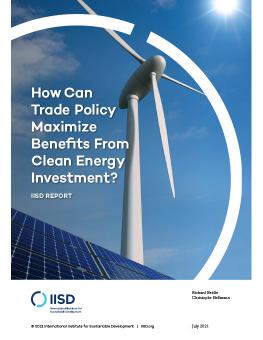
How Can Trade Policy Maximize Benefits From Clean Energy Investment?
Wind and solar projects typically involve a mix of components manufactured in a few places at very large scales, but also components that can be produced in many countries. Given the boom in the construction of renewable energy projects, national governments are increasingly keen to maximize local economic benefits. In recent years, they have progressively used a range of instruments, including trade policy measures such as local content requirements or import tariffs to incentivize domestic production. This paper assesses the role of trade in stimulating local capacity while avoiding increases in project costs and consumer prices that can delay the renewable energy transition.
-
In low-income and lower-middle-income countries, import tariffs on components sourced globally such as wind turbines or solar modules tend to be lower than those applied to components that are easier to be sourced domestically.
-
Depending on the context, the imposition of tariffs on components that are suited to local production may stimulate the deployment of additional productive capacity. By contrast, tariffs on components whose production is centralized in a small number of countries tend to reduce the deployment of renewable energy.
-
At the international level, initiatives to liberalize environmental goods and services should be accompanied by incentives that support the competitive local production of components to help to build the political and economic case for a transition to renewable energy.
The growth of renewable energy is one of the most significant developments in the global electricity market over the last two decades. Costs have reached a point where renewable energy is competitive in almost all countries. While wind energy generators or solar modules still tend to be procured from global manufacturers, a wide range of components such as blades, electrical components, or civil work can increasingly be procured and built locally.
Today, most low-income and lower-middle-income countries are net importers of wind and solar components. They tend, however, to impose lower tariffs on components sourced globally such as wind turbines or solar modules than components that are easier to source domestically. Depending on the context, the imposition of tariffs may stimulate the deployment of additional productive capacity, particularly for products that are suited to local production. A good example is the production of heavy or bulky components such as wind towers, for which minimizing transport distances provides a cost advantage. In these cases, however, there is a need to balance the likelihood of achieving competitive production with increased project cost and the economic value of local production.
These considerations have, in turn, implications for future initiatives at the regional or plurilateral level to liberalize environmental goods and services and the participation of developing countries.
Participating experts
You might also be interested in
Net-Zero Should Not Be a Net Loss for Low-Income Economies
As countries make the transition towards net-zero economies, what do these policies mean for international trade?
Can Trade in Electric Vehicle Raw Materials Create Development Opportunities?
As demand grows for electric vehicles, there are valuable lessons to learn from Chile and the Democratic Republic of the Congo.
How Can Trade Maximize Gains From Clean Energy Investment in Developing Countries?
As governments increasingly turn to trade policy to support the renewable energy transition, they also need to encourage the production of key components at home.
Border Carbon Adjustments: Priorities for international cooperation
This IISD policy brief looks into border carbon adjustment design elements that are priorities for international cooperation, as well as the possible venues, formats, and shapes that such a discussion might take.